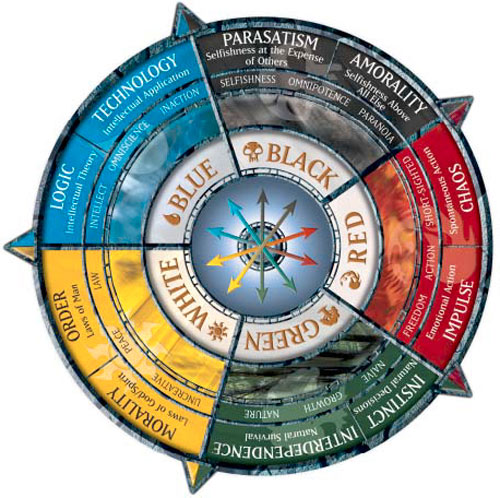
Last update 15-10
- Added when a player receives a Colour Token. Also clarified that Colour Alignment also replaces Inspiration.
Allowed resources
These are the books and resources you may use to create your character. If you are missing something on this list, let me know!
- Basic Rules for D&D
- Player’s Handbook
- Elemental Evil Player’s Companion
- Unearthed Arcana articles:
- Eberron Note: Only the Warforged and Artificer are allowed
- Awakaned Mystic Note: this is a Psionic Class
Optional rules
During the campaign we use the following optional and homebrew rules:
- Feats PHB 165
- Color Wheel Alignment Homebrew, see below
This replaces the Alignment section from PHB Chapter 4. It also replaces Inspiration. - Gnolls Playable Race
Color Wheel Alignment

Instead of the standard D&D Alignments, we have coloured alignments. Each colour stands for a personality trait. Your colour is based on your actions. There is no definition of Good or Evil between colours, Good or Evil are just two sides of the same coin, or in this case, Colour Wheel.
The five colours are:
- White
- Blue
- Black
- Green
- Red
White
Stands for Order, Community and Morality.
- Good example Angels, Jedi (Star Wars), Friar Tuck (Robin Hood)
- Evil example Senator Palpatine (Star Wars), Dictators like Hitler (real world)
White actions have the Radiant keyword
Blue
Stands for Logic, Knowledge and Technology
- Good example Spock (Star Trek), Mr. Fantastic (Marvel Comics)
- Evil example Lex Luthor (Superman), Two-Face (Batman)
Blue actions have the Force keyword
Black
Stands for Amorality and Selfishness. Possibly Wealth
- Good Example Han Solo (Star Wars), Captain Jack Sparrow (Pirates of the Caribbean)
- Evil Example Sauron (LotR), Voldemort (Harry Potter)
Black actions have the Necrotic keyword
Red
Stands for Freedom, Emotion, Chaos, Impulse
- Good Example Hulk (Marvel Comics)
- Evil Example Joker (Batman)
Red actions have the Fire Keyword
Green
Stands for Instinct, Nature
- Good Example Radaghast the Brown (LotR), Wolverine (X-Men)
- Evil Example Green Peace (real world)
Green actions have the Thunder keyword
Allied and Enemy colours
The allies of a colour are the two other colours that lie directly next to it, on the Color Wheel. For example, White is an Ally of Blue and Black is an Ally of Red The enemies of a colour are the two colours opposite on the Color Wheel. For example, Black is an enemy of White and Blue is an enemy of Green and Red. Enemies are super effective against each other. Allies are not very effective against each other. Take this into account when using your Colour Tokens.
When do I get tokens?
Colour Tokens are a way for the DM to say “You’re awesome!”. You get colour tokens in the following cases:
- Whenever you complete a quest
- When you are roleplaying awesomely
Your humble DM is fallable, so don’t forget to ask if something is worth a token!
Rules
- When ever you make a roll, you may use a Colour Token to re-roll a die
- Whenever you use a Colour Token; the action you take gains the color of the token.
- If, at the start of the session, you have no tokens, you gain 1 Coloured Token of your choice. This token should reflect your PC’s personality
- If you end end a session with more than 0 tokens, you keep those tokens for the next session.
The type of game
During the second session we, as a group, answered some questions, to determine what kind of game we want to play. Here are the results:
- Do you play to win? b) Good play isn’t a win/lose kind of thing. We want to play our characters!
- Player characters are: b)/c) expected to work together; but major conflicts might erupt. We’d might patch them up, they might stay.
- The GM’s role is: b) The GM preps a map with NPCs and/or monsters. The players have their characters travel anywhere they can reach on the map, according to their own goals.
- The players’ roles are… b)/c) …to set goals for their characters, and pursue them proactively. They might get in tough, unwise siutations
- Doing the smartest thing for your character’s survival… b) …sometimes isn’t as important as other choices
- The GM’s role to the rules is… b) …ignore them when they conflict with what would be good for the story
- After many sessions of play, during one session, a player decides to have her character side with an enemy. This is… c) …something the player and the GM should discuss
- A fistfight breaks out in a bar! The details of where everything is – tables, chairs, where everyone is standing is something that… a) …is important and will be displayed on a map or grid, perhaps using miniature figures. But anyone can come up with a detail, if it makes sense or is cool.
- In order to really have fun with this game, the rulebook is something that… d) …everyone at least should know the basics of the rules.
Credits These questions are from the Same Page Tool